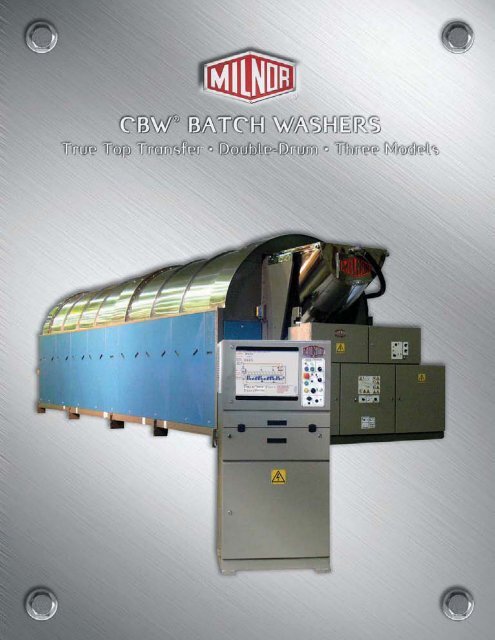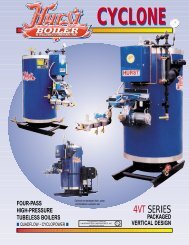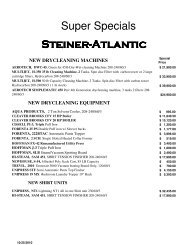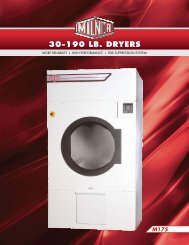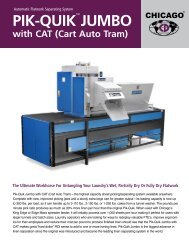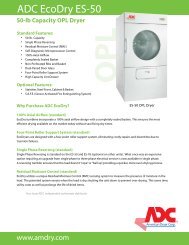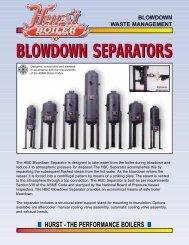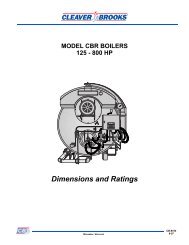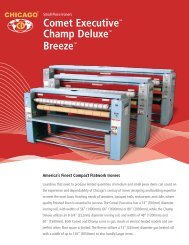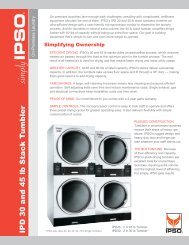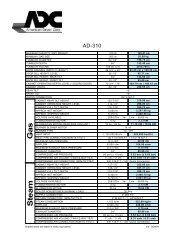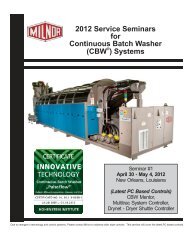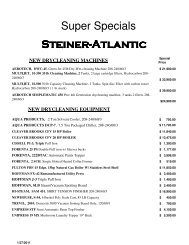CBW Batch Washers Brochure - Steiner-Atlantic
CBW Batch Washers Brochure - Steiner-Atlantic
CBW Batch Washers Brochure - Steiner-Atlantic
Create successful ePaper yourself
Turn your PDF publications into a flip-book with our unique Google optimized e-Paper software.
A variety of arrangements.<br />
Each Milnor <strong>CBW</strong> washer is custom-made for the<br />
customer’s specific needs. More modules give greater<br />
production. Water inlets and drain valves give<br />
greater flexibility. Mentor control allows<br />
predetermined temperature and chemical levels for<br />
each individual bath.<br />
Mentor ® Control.<br />
The operator puts a batch in line for loading, then<br />
enters the goods classification number into the<br />
Mentor control. This automatically selects the<br />
processing formula which follows the batch until it’s<br />
automatically unloaded from the dryer and delivered<br />
to its finishing destination.<br />
Loading.<br />
A conveyor or overhead bag system may feed the<br />
load chute.<br />
Washing.<br />
Each module has a stationary shell – to hold the<br />
wash bath – and a rotating, perforated inner<br />
cylinder. Each module can be used for different<br />
baths. Goods proceed through the formula by<br />
traveling from module to module, via a perforated<br />
top transfer scoop. There are no stops and starts for<br />
draining and filling after each bath. This saves time,<br />
compared to conventional washing machinery.<br />
Temperature controls.<br />
Any module can be equipped with a steam inlet<br />
and temperature probe.<br />
Supplies.<br />
Supply inlets can be placed in each module.<br />
The Mentor control dictates the amount of supplies<br />
and when – or if – they are added to the specific<br />
goods in each module during the wash cycle.<br />
Post-wash.<br />
The MultiTrac system relays each batch’s<br />
post-wash requirements to other parts of the system<br />
– extractor, shuttle, dryers, and conveyors.<br />
A CRT display identifies batch location and status.<br />
Where multiple-batch dryers are used, the control<br />
system prevents mixing of incompatible batches in<br />
the same dryer.<br />
1
Tunnel washers were developed to save water, energy<br />
and labor, and to expedite the flow of goods through<br />
the laundry. Since they entered the market in the<br />
1960s, they’ve all done this to some degree.<br />
Early tunnel washers were bottom transfer machines.<br />
To move the goods from one stage of the washing<br />
process to the next, they transferred the goods and<br />
ALL the water along the bottom. Even the first<br />
successful batch tunnels did this. And today, the<br />
same is still true of some tunnel washers made by<br />
others.<br />
But the Milnor <strong>CBW</strong> washer has taken tunnel<br />
washing another step forward. This is a top transfer<br />
machine. It lifts and drains the goods before<br />
transferring them into the next processing stage.<br />
This results in a high level of wash quality for<br />
a range of goods – everything from light hospitality<br />
2<br />
linen to heavy-soil industrial goods can be laundered<br />
in a Milnor <strong>CBW</strong> washer.<br />
There are other features that set a Milnor <strong>CBW</strong><br />
washer apart from other tunnels – such as modular<br />
construction and double drum characteristics<br />
throughout. What distinguishes a Milnor tunnel<br />
washer from the competition are better dilution,<br />
higher wash quality and more rugged construction.
Top transfer increases productivity.<br />
Milnor top transfer <strong>CBW</strong> washers have proven higher productivity in more than 1,300 installations worldwide. They wash faster than other tunnel washers due<br />
to superior dilution – which means better soil removal. This yields two major advantages:<br />
B More production in a given number of compartments, or…<br />
C Fewer compartments to achieve the same production. Both of these advantages save wear and tear on the goods.<br />
Milnor’s better washing quality – and higher productivity – result from:<br />
•Better dilution. •Better wash liquor penetration. •Better mechanical action. •More cylinder space.<br />
Better dilution means<br />
processing.<br />
The proven result of all of this:<br />
Dilution is far greater in a Milnor than in other tunnels.<br />
That’s the main reason Milnor can wash and rinse more quickly,<br />
and why Milnor can also wash heavily soiled goods so well.<br />
Why Goods Get Cleaner Faster<br />
With Total Top Transfer.<br />
Milnor’s perforated top transfer scoop leaves dirty water behind.<br />
Linen see cleaner water in the next bath - for better dilution. Note bath separation.<br />
How transfer affects dilution.<br />
A tunnel washer’s transfer method is critical, because it’s the way the machine<br />
introduces each batch of goods to its next bath. And, of course, dilution will be<br />
best served if the next bath has cleaner water.<br />
Milnor transfers each batch by lifting the goods out of the water, draining the<br />
free water, then sliding the goods into the next compartment. Goods are<br />
immediately exposed to cleaner water. Only the water trapped in the goods moves<br />
forward – most dirty water is left behind. Milnor leaves back approximately half<br />
of the total water in each compartment.<br />
You can see the effect of total top transfer vs. other<br />
methods by using buckets of water to simulate<br />
different compartments. A Milnor loading scoop lifts<br />
the goods, drains them, and deposits them into<br />
cleaner water.<br />
Other tunnels transfer by forcing the goods and the dirty water forward, generally<br />
along the bottom of the tunnel. Instead of a cleaner bath upon transfer, goods<br />
are exposed to the same dirty water that was in the previous bath!<br />
That’s why, at the unload end of a Milnor <strong>CBW</strong> washer, there’s hardly any free<br />
water when the goods transfer into the press. Other tunnels have a wave of water<br />
splashing into the press, along with the goods. And what happens at the end<br />
happens in every other compartment of the machine, as well.<br />
3<br />
Other tunnels send dirty water into the next<br />
compartment, along with the goods.There’s no<br />
dilution as the whole compartment moves forward.
MILNOR’S DILUTION ADVANTAGE<br />
Top transfer gives better<br />
control of chemicals.<br />
Milnor’s top transfer feature assures bath integrity.<br />
Baths are truly independent, so the washing formula<br />
can work as planned.<br />
Because water is not pumped forward with each<br />
transfer, chemicals are better targeted to the<br />
proper baths. They don’t migrate uncontrollably to<br />
subsequent baths. Titrations show that with a Milnor,<br />
it is far easier to control pH.<br />
What is<br />
“True Top<br />
Transfer”?<br />
To acheive all of the benefits<br />
of True Top Transfer,<br />
a tunnel washer must include:<br />
1. A scoop that lifts each batch out of the<br />
water and transfers it to the next chamber.<br />
2. Perforations in the lifting scoop that allow<br />
almost all of the “free water” (the water not<br />
trapped in the goods) to flow back into the<br />
original module and not be carried forward<br />
with the load.<br />
3. A solid partition between modules<br />
to completely separate chemical baths.<br />
4. No perforations in the partitions so bath<br />
integrity is maintained at all times.<br />
5. The partition should be fixed to the outer<br />
drum so that no sliding seals are required<br />
to completely separate baths.<br />
6. All flow between modules should be<br />
external, so flows can be changed on<br />
command when necessary and proper water<br />
levels can be maintained.<br />
The results are clear.<br />
Dilution is the way goods are washed. It’s always been<br />
true of conventional washers and washer-extractors.<br />
It’s also true of tunnel washers. Time, temperature,<br />
chemicals and mechanical action are essential<br />
elements of the washing process. These four things<br />
loosen soil from the goods and dissolve/suspend<br />
What about counterflow?<br />
Counterflow – water moving against the direction of<br />
the goods – also achieves dilution. With counterflow,<br />
a tunnel washer would get almost the same dilution<br />
as a washer-extractor gets with one dump and fill,<br />
using reuse water. This is true of both the Milnor top<br />
transfer washer and other tunnels. But a Milnor<br />
<strong>CBW</strong> washer, with its perforated top transfer scoop,<br />
HIGH<br />
Chemical Concentrations<br />
LOW<br />
the soil in water. But these four catalysts can only<br />
remove soil if water washes it away. That’s dilution<br />
– successive baths, each with cleaner water,<br />
each replacing dirtier water. Without dilution, the<br />
dirt cannot be removed from the linen.<br />
goes a big step further. The goods change baths upon<br />
transferring. So, again except for reusing the water<br />
over and over in each module, Milnor achieves<br />
approximately the equivalent of a second dump<br />
and fill – and about twice the dilution of some other<br />
tunnels.<br />
TOP TRANSFER AT WORK:<br />
Compare Titrations<br />
This video<br />
sequence shows<br />
how Milnor<br />
leaves dirty<br />
water behind.<br />
Note the similarity between titration curves<br />
of a washer-extractor and a Milnor <strong>CBW</strong> washer.<br />
In both, chemical concentrations are high where<br />
soil is heaviest. Then, concentrations drop sharply<br />
in the next stage of the formula as soil is removed.<br />
Compare this to a bottom transfer tunnel’s<br />
flatter curve: Lower peak concentration<br />
where chemicals are added<br />
1 2 3 4 5 6 7 8 9 10 11 12 13 14 15 (because so much water has<br />
15-Compartment Bottom Transfer Tunnel<br />
been transferred from previous compartments),<br />
1 2 3 4 5 6 7 8 9<br />
and spillover of chemicals in subsequent stages<br />
9-Module Milnor <strong>CBW</strong> Washer<br />
(where a washer-extractor and a Milnor <strong>CBW</strong><br />
Washer-Extractors<br />
washer have already removed most chemicals).<br />
4
More Cylinder Space For Better Wash Liquor Penetration<br />
Removes soil effectively.<br />
Every module – not just the first – is big, so wash<br />
liquor can flow freely into and out of the linens.<br />
Milnor’s high mechanical action effectively loosens<br />
and moves dirt out of the fibers.<br />
Tall ribs are strategically spaced for multiple drops.<br />
All cylinders are perforated, and perforations are<br />
large and plentiful. Forty percent of the cylinder’s<br />
perforated area is open, so water and soil flow easily<br />
into and out of the cylinder.<br />
Bath separation<br />
enhances quality.<br />
With a solid partition between each and every<br />
wash cylinder, Milnor keeps all baths independent.<br />
Water travels from one module to the next via<br />
exterior piping, so it is controllable. Better bath<br />
integrity helps wash formulas work as planned.<br />
Chemicals don’t migrate uncontrollably.<br />
MILNOR: Every module is large and of identical size.<br />
Milnor gives the goods more space to move.<br />
In other tunnels, the first compartment must be large<br />
enough (because the goods are bulky before they’re<br />
thoroughly wet down). But the rest of a bottom<br />
transfer tunnel’s compartments – all the rest –<br />
are much smaller.<br />
Large cylinder volume allows water and chemicals<br />
to penetrate goods more quickly for faster washing<br />
in fewer modules.<br />
More space<br />
means more speed.<br />
The more space there is, the more room there is for<br />
movement of the goods. Goods can open up, so wash<br />
liquor – water and chemicals – can penetrate the<br />
entire load quickly.<br />
Chemicals need time to do their job. Obviously they’ll<br />
finish the job faster if they get to the entire load faster.<br />
Since Milnor’s low loading ratio and high mechanical<br />
action drive water and chemicals into the goods more<br />
quickly, the Milnor <strong>CBW</strong> washer needs less time to wash.<br />
MORE SPACE: In a Milnor, goods open up for<br />
better penetration of water and chemicals.<br />
TIGHTLY PACKED: Chemicals cannot penetrate<br />
the entire load as quickly in a competitive tunnel.<br />
5
Why mechanical action<br />
is so important.<br />
Mechanical action speeds up dilution.<br />
Water and chemicals penetrate the load faster,<br />
and soil is removed more quickly.<br />
How Milnor Produces<br />
Superior Mechanical Action<br />
Without mechanical action.<br />
With no mechanical action at all, some soil<br />
gradually exits the goods. That’s because<br />
with water present, some dilution occurs.<br />
Another reason for Milnor’s speed is apparent<br />
if you look down the loading chute, into the first<br />
compartment of the tunnel. Lift and drop action<br />
is obviously great in a Milnor <strong>CBW</strong> washer.<br />
EXCELLENT WASH ACTION with high ribs.<br />
Three factors contribute to greater turbulence inside<br />
the washing cylinder: More space, high ribs that are<br />
strategically positioned, and a rotational speed that<br />
uses these features to best advantage.<br />
With mechanical action.<br />
Add mechanical action, and soil can exit much<br />
more quickly. Mechanical action aids dilution.<br />
Dropping the goods squeezes out the water and<br />
chemicals inside them. When the goods relax<br />
– at the bottom of the cylinder – they open up<br />
and absorb more wash liquor.<br />
The significance is this: Once goods transfer to a new<br />
bath, they must be penetrated by that new bath<br />
as quickly as possible. High mechanical action simply<br />
aids dilution better than low mechanical action.<br />
(And because goods spend less time in the washer,<br />
there is less wear and tear!)<br />
Up to 44 drops a minute.<br />
Milnor <strong>CBW</strong> Washer<br />
is ideal for industrial soil.<br />
Properly-designed batch washers can wash better,<br />
faster and at lower cost than any washer-extractor<br />
– even when doing heavy industrial soil items.<br />
Milnor <strong>CBW</strong> systems are washing heavy soil to<br />
excellent quality standards in plants across the<br />
world.<br />
Milnor provides the kind of washing action you’d<br />
only expect in an industrial washer-extractor.<br />
In fact, the Milnor <strong>CBW</strong> washer’s mechanical action<br />
has been documented by internationally recognized<br />
tests to equal – and even exceed – that of many<br />
industrial-size washer-extractors!<br />
In addition to higher wash quality, other<br />
advantages are savings in utilities and labor,<br />
faster processing of small batches.<br />
6
Mentor ®<br />
Control<br />
for<br />
<strong>CBW</strong> ®<br />
<strong>Washers</strong><br />
On-screen tech<br />
& PM help.<br />
The Mentor controller does much more than alert<br />
you to any errors that might occur. It also offers<br />
instant, on-screen access to guided troubleshooting<br />
steps. It even displays pertinent service procedures<br />
and – in many cases – service manual pages.<br />
This information can be printed for hardcopy<br />
reference. A preventive maintenance alert – with<br />
verification requirement – is also available.<br />
The Mentor ® Control expands your laundry’s capabilities and tells you what’s going on.<br />
A format that’s familiar,<br />
easy to use.<br />
The Mentor controller makes it easier for you<br />
to capitalize on the Milnor <strong>CBW</strong> Washer’s vast<br />
capabilities. With graphic displays and mouse-click<br />
operation, it saves time in programming and<br />
maintenance. Different password levels ensure<br />
security and familiar Windows ® based format makes<br />
all operations more intuitive. This saves training<br />
time. Another advantage is one-stop data backup<br />
and restoration, using standard media.<br />
· Operational display gives key information for<br />
each batch in the loading system and washer.<br />
To monitor activity in a specific tunnel module,<br />
you click on the module on-screen. A window<br />
gives details. This window even lets you manually<br />
actuate chemical valves and other functions.<br />
· Pulldown menus speed up operating procedures<br />
and make it easy to find information. Operators<br />
can click on menu choices (in real words) rather<br />
than type in codes.<br />
· On-screen help messages explain terminology<br />
– an excellent training tool and a timesaver for<br />
experienced personnel.<br />
Programming is<br />
easier & faster.<br />
You program the Mentor controller by formula<br />
– not by module – on only one screen. Formulas<br />
are virtually unlimited. Shortcuts and timesaving<br />
features aid programming. You can define several<br />
related output signals (e.g., all alkali valves) as a group.<br />
· A formula is programmed step-by-step, entirely<br />
on this screen. This includes such functions as<br />
chemical injection, bath temperature, formula<br />
length, permissible load weights, and assigned<br />
dry codes. Formulas get more meaningful names<br />
because more characters are available.<br />
· The Mentor controller makes several operations<br />
automatic – such as chemical dosing after a goods<br />
change, based on user-assigned compatibility.<br />
· Copying parts of one formula to another can save steps<br />
in programming formulas for simpler goods classes.<br />
· Chemical multiplier lets you modify all formulas<br />
in one step.<br />
This shortcut saves time<br />
when you change chemicals<br />
or chemical supply valves.<br />
It also helps you fine-tune<br />
chemical use.<br />
· The controller signals an error and provides<br />
a step-by-step troubleshooting guide. Service<br />
manual pages, including illustrations and<br />
schematics, can also be viewed on-screen.<br />
The Mentor controller can be retrofitted to<br />
many earlier <strong>CBW</strong> <strong>Washers</strong> with serial controls.<br />
All displays and descriptions subject to change<br />
without notice.<br />
Windows ® is a registered<br />
trademark of Microsoft Corporation.<br />
7
Mildata ® system – a versatile plant management tool.<br />
Monitors the entire washroom<br />
Milnor’s Mildata ® Computer Network provides<br />
complete personal computer monitoring and<br />
reporting on washing equipment including batch<br />
washers, washer-extractors and dryers. The result is<br />
a built-in management network for the laundry or<br />
textile plant.<br />
The Mildata system can provide data collection,<br />
report generation, central programming and system<br />
monitoring. With this system, management has<br />
instant access to production and can take immediate<br />
steps to streamline productivity for a more efficient,<br />
profitable operation.<br />
Moreover, the system allows all functions to be<br />
accessed on-site, at remote locations or via the<br />
internet – an important consideration for companies<br />
with multiple locations or off-site personnel.<br />
Central on-line programming<br />
The Mildata system provides easy on-line<br />
programming of formulas at central terminals.<br />
Changes that took hours to program before take only<br />
minutes.<br />
Throughout all programming, help displays are<br />
available at the touch of a button to speed the<br />
programming process. There is no need to refer to<br />
the manual for programming help.<br />
Programming advantages include:<br />
• No lost production time – Equipment in<br />
progress is not interrupted while programming<br />
alterations.<br />
• Remote programming – Especially<br />
important in multiple-plant situations – or when<br />
traveling personnel are involved.<br />
• Simplified dryer programming –<br />
Dryers with Mark II and later microprocessors can be<br />
programmed as a bank, rather than individually.<br />
Compare real-time operations to<br />
pre-set benchmarks<br />
Mildata MilMetrix software allows you to see, at a<br />
glance, if you’re keeping up with expected<br />
performance throughout your laundry or on a<br />
machine by machine basis. This allows you to address<br />
any machine issues (like a low pressure error<br />
message) before it affects your daily numbers.<br />
8<br />
Concise, meaningful reports – when<br />
and how you want them<br />
Mildata MilMetrix software records raw data such<br />
as batch, weight, type, number of pieces, machine<br />
faults, downtime and diagnostics for each load of<br />
goods. This information is sorted and tabulated to<br />
provide several reports, including:<br />
• Machine production – Real time versus<br />
calculated time and load information.<br />
• Chronological load with water – Load<br />
information by machine.<br />
• Formula mix – How many loads of each<br />
formula per machine, total and per machine.<br />
• Machine utilization – Information related<br />
to machine usage and percentage of utilization.<br />
• Employee output – Number of loads<br />
produced, number of pieces, actual hours worked<br />
versus total workday, error time and wait time.<br />
• Customer output – Number of loads<br />
produced, weight and number of pieces.<br />
• Goods formula-output – Actual wash<br />
time versus benchmark.
Modular Design • 250lb. (115 kg) <strong>Batch</strong>es<br />
92048 <strong>CBW</strong> Washer<br />
Milnor’s modular top transfer <strong>CBW</strong> washers consist<br />
of individual, double-drum modules – each with<br />
their own individual drive and support elements –<br />
like several washing machines linked together.<br />
Shell<br />
Milnor’s modular, top transfer design, with<br />
double-drum construction throughout, yields<br />
several important benefits over competitive<br />
bottom transfer tunnels.<br />
Cylinder<br />
MILNOR: Modular shell-and-cylinder design.<br />
Each module of a <strong>CBW</strong> washer<br />
is a separate unit, providing<br />
easy access into laundries with<br />
limited entry.<br />
Add capacity later.<br />
If volume increases later, you can easily add modules<br />
– without the cutting, welding or remanufacturing<br />
required by other tunnels.<br />
MILNOR ADVANTAGES<br />
Greater flexibility.<br />
Because water travels over weirs and via external<br />
pipes from one module to the next, there is absolute<br />
water control. Many waterflow alternatives are<br />
available. Fills, drains, counterflows and alternative<br />
counterflow/drain can be factory-installed and<br />
revised in the field. You can also easily change any<br />
chemical input, water input, or drain. Each module<br />
can have its own steam supply and electronically<br />
controlled temperature. Compatibility programs<br />
facilitate switching from one type of goods to another<br />
by changing the parameters.<br />
A Milnor <strong>CBW</strong> washer can be linked to a membrane<br />
press, a centrifugal extractor, or both a press and a<br />
centrifugal extractor. There is also a choice of dryer<br />
sizes and materials handling systems.<br />
You’re not locked into<br />
today’s classifications.<br />
Milnor tunnel designs allow broad freedom with<br />
washing formulas. Changes are made automatically<br />
from one formula to the next. Plain-language<br />
programming commands supply injection times in<br />
seconds and temperature in C˚/F˚.<br />
You have several choices as to when injection can<br />
occur – after the desired temperature is achieved,<br />
after level is achieved, etc.<br />
If you change goods classifications later, you can<br />
modify the washer to cope with radically new<br />
formulas. The wash-to-rinse module ratio is<br />
changeable, as each module is a distinct entity.<br />
Water, steam, and liquid supply inlets for any<br />
module can be added or altered in the future,<br />
without physically disassembling the washer<br />
– or entering the machine.<br />
9
Multi-Module Section Design<br />
110lb. (50 kg) or 150lb. (68 kg) <strong>Batch</strong>es<br />
76028 or 76039<br />
<strong>CBW</strong> Washer<br />
These streamlined machines have reduced the<br />
number of drive and support components for easier<br />
installation and servicing, and make better use<br />
of valuable floorspace. Intact are the essential<br />
features that make Milnor tunnels so popular<br />
throughout the world – top transfer, excellent bath<br />
separation, double drum construction, and a high<br />
level of flexibility.<br />
Multi-Module sections offer<br />
streamlined design to meet a variety<br />
of needs. Sections can be added later.<br />
Streamlined drive –<br />
and easier access.<br />
There are now fewer moving parts than ever –<br />
including fewer motors, gear reducers, and chains.<br />
A direct-driven gear reducer eliminates belts<br />
and pulleys.<br />
Drive components have been minimized.<br />
An eight-module tunnel has only two motors, two<br />
gear reducers, and two chains.<br />
In the new centralized control system, input/output<br />
board optimization allows for fewer boards. The<br />
system has only as many boards as are required<br />
for its inputs and outputs. Controls have also been<br />
moved to where they are easily accessible to service<br />
technicians.<br />
Service and maintenance points are concentrated<br />
in easy-to-reach locations. Valves, for example, are<br />
now lower so they can be reached from floor-level.<br />
A welded steam manifold results in a streamlined<br />
steam injection design.<br />
Engineered for<br />
fast installation<br />
Installation is simplified through single-point hookups<br />
for water, steam, air, and electricity. These components<br />
are also located within reach – without use of a ladder.<br />
Chemical hookup is easier, too, with potential of six<br />
connectors on each module. Flow splitters and lifters<br />
are more compact, and they feature integral pumps,<br />
piping controls, and wiring for fast connections.<br />
Better design.<br />
The Milnor <strong>CBW</strong> washer injects water,<br />
supplies, and steam into a stationary outer<br />
shell. And it can drain from a stationary shell.<br />
Any - or every - module can be equipped with<br />
chemical injection (dosing box for sectional<br />
tunnels shown here).<br />
High wash quality.<br />
Milnor’s double-drum design delivers high washing<br />
quality. Baths are kept separate (due to top<br />
transfer), so chemical injection is more controllable.<br />
Easier to bring<br />
into tight places.<br />
Finding a location is made easier by modular design,<br />
too. The <strong>CBW</strong> washer can be brought into the<br />
laundry in sections and assembled without on-site<br />
manufacturing.<br />
10
No other commercial laundry machinery manufacturer matches Milnor resources in design, testing, and manufacturing. Examine a Milnor <strong>CBW</strong> washing system<br />
closely, and you’ll see that Milnor doesn’t cut corners. That’s why you can expect the kind of capabilities discussed on previous pages. You can also expect the machine<br />
to perform as it’s supposed to perform – and cope with heavy use – for many years to come.<br />
Here are some of the extra steps Milnor takes<br />
to provide a superior batch washing system.<br />
Designed for simplicity<br />
and strength<br />
By increasing component heft in key areas,<br />
Milnor can use fewer components. Rugged support<br />
and drive components are backed by a five-year<br />
extended, limited warranty (ask your Milnor dealer<br />
for details).<br />
Torque – the twisting motion typically exerted<br />
on welded tunnel cylinders with each reversal –<br />
is transmitted only short distances. And Milnor’s<br />
rugged cylinder construction has been proven in<br />
operation and in fatigue tests using computer<br />
equipment unique in the industry.<br />
Components<br />
are conveniently<br />
located. New,<br />
simpler steam<br />
manifold streamlines<br />
design.<br />
Double drum design<br />
simplifies inlets.<br />
Milnor’s stationary outer shell (the machine is<br />
double drum throughout) simplifies injection of<br />
water, supplies, and steam – plus draining and<br />
gauging temperature. This design also makes it<br />
easier to add these components later. Friction seals<br />
are not required.<br />
Greater flexibility.<br />
Every Milnor module can have its own steam<br />
supply, with thermostatically controlled temperature.<br />
Drains can be added easily (for example, to change<br />
the wash time/rinse time ratio). Some Milnor models<br />
can automatically revise waterflow configuration,<br />
depending on the goods class. Milnor’s double drum<br />
design allows easier insertion of chemical probes any<br />
place they’re needed. And water, steam and supply<br />
inlets can be added or changed without physically<br />
disassembling the washer. With bottom transfer<br />
tunnels, design constraints severely limit flexibility<br />
and subsequent modification.<br />
Enhanced water savings.<br />
Water use in a Milnor<br />
<strong>CBW</strong> washer can be further<br />
reduced with optional<br />
PWR Zone (Press<br />
Water to Rinse Zone)<br />
water flow. This optional<br />
flow pattern with surge<br />
tank allows the customer to take maximum advantage<br />
of reuse water. That water is reused like this:<br />
• Excess water from the last module is collected in<br />
the surge tank, along with extracted water from the<br />
membrane press or centrifugal extractor.<br />
• That surge tank water is split between the rinse<br />
zone of the <strong>CBW</strong> washer and the reuse flush tank.<br />
The option includes a surge tank with wedge wire<br />
screen to help remove lint from the water. Total fresh<br />
water savings when processing typical healthcare and<br />
hospitality work is approximately 25%*. This option<br />
is available as a retrofit to existing <strong>CBW</strong> systems.<br />
* Results may vary depending upon batch sizes, chemical use and wash settings.<br />
Fits the desired layout.<br />
Many laundries find they can increase capacity,<br />
yet use less space than with conventional washing<br />
machinery. Loading conveyors (if used), extracting<br />
and drying equipment can be positioned in-line or<br />
at right angles to form an L- or U-shaped layout.<br />
There is a wide choice of Milnor conveyors to help<br />
you cope with awkward or tight layouts. And the<br />
<strong>CBW</strong> Washer is ideal for barrier arrangements<br />
separating areas where soiled and clean goods are<br />
located. That’s because work enters one end and exits<br />
the other.<br />
11
Components packaged<br />
for easy reach.<br />
These <strong>CBW</strong> washers<br />
are packaged for<br />
accessibility, to speed<br />
maintenance if it’s<br />
necessary. Easy-toreach<br />
components are<br />
grouped in an orderly<br />
manner. Plumbing can<br />
be accessed quickly. It’s<br />
neatly located within the machine’s frame<br />
to prevent bumping by carts, etc.<br />
Special features help<br />
solve special problems.<br />
Several Several optional optional features features are are programmable programmable as needed: as<br />
• needed: Flush enhance Flush enhance increases increases flushing action flushing the action first in<br />
module the first and module – when and used – with when one used or two with 8” one drain or valves two<br />
– 8” can drain be used valves to flush – can non-solubles be used to from flush the non-solubles shell sump.<br />
• from Wash the enhance shell sump. helps remove Wash enhance heavy soil helps more remove effectively<br />
by heavy stepping soil up more the effectively flow rate in by the stepping appropriate up the washing flow<br />
modules. rate in the appropriate washing modules. Rinse<br />
• enhance Rinse enhance accelerates accelerates the flow the rate flow rate in the in desired the desired rinse<br />
rinse modules.<br />
modules. Flow/no flow lets you interrupt counterflow<br />
• Flow/no flow lets you interrupt counterflow on demand<br />
on demand (or allow counterflow in a module where<br />
(or allow counterflow in a module where it normally does<br />
not<br />
it normally<br />
occur).<br />
does not occur). Overhead fast fill tank<br />
• quickly Overhead fills fast a module fill tank that quickly has fills just a been module drained that has to<br />
just prevent been thermal drained to shock. prevent Workwear thermal shock. features help purge<br />
• weir Workwear boxes and features shell help sumps purge of weir heavy boxes non-solubles and shell<br />
sumps and metal of heavy particles, non-solubles etc. – and manually metal particles, or automatically. etc. –<br />
manually After the or machine automatically. has run After a commanded the machine has number run of<br />
a loads, commanded the Autopurge number of feature loads, the removes Autopurge non-solubles feature by<br />
removes automatically non-solubles passing by automatically “empty holes” passing and calling “emptyfor<br />
holes” and calling for fills and drains.<br />
fills and drains. Last module dual bath, typically used<br />
• Last module dual bath, typically used in smaller systems<br />
in smaller systems with longer transfer times, gives<br />
with longer transfer times, gives the last module a dual<br />
function:<br />
the last<br />
rinse<br />
module<br />
(counterflow)<br />
a dual function:<br />
for part<br />
rinse<br />
of the<br />
(counterflow)<br />
time, standing<br />
bath for part for the of remainder. the time, standing bath for the remainder.<br />
• Bath Bath exchange – where counterflow is is minimized<br />
or<br />
or eliminated and replaced with draining and and filling filling of<br />
of individual modules – can be useful where colored goods<br />
are goods followed are followed by white. by white.<br />
Drive systems are simple,<br />
dependable, efficient.<br />
All drive and support elements (including motors)<br />
are small, easy to change if necessary, and designed<br />
for dependability.<br />
Flexible couplings interconnect drive units, and<br />
cylinders are keyed end-to-end. Drive components<br />
are located in a dry zone for reliability and easy<br />
maintenance. Drive system bearings are lubricated<br />
from outside the machine.<br />
Oversized motor housings dissipate heat for longer<br />
life. “Soft start”, created by alternate starts of<br />
motors, removes heavy shock load on drive<br />
components, increases motor life, and reduces<br />
ampere demand(modular washers). Inverter drive on<br />
sectional <strong>CBW</strong> washers also reduces ampere demand.<br />
Warranty<br />
Milnor’s rugged cylinder support, drive and seal<br />
components are backed by a five-year extended<br />
warranty. For support wheels, the full price is<br />
covered up to five years after the machine’s<br />
manufacturing date. For all the other drive<br />
components (including motors, chains, sprockets,<br />
gear reducers, couplings, V-belts, and pulleys)<br />
and seal components, the full parts price is<br />
covered up to two years, and a pro rata amount<br />
is absorbed for the next three years.<br />
Compatibility Features<br />
Compatibility features can prevent an operator from<br />
putting goods onto a loading conveyor in an<br />
unauthorized sequence (no whites after reds, for<br />
example). It also can recognize the first time a<br />
heavy-soil batch enters a module after a more lightly<br />
soiled batch. In this case, it automatically provides<br />
higher “first dosing” to correctly raise the chemical<br />
concentration in that module. Afterwards, it adds<br />
lighter maintenance doses of the chemicals for each<br />
successive load of the same goods. Another use of<br />
Compatibility is optional Bath Exchange – which<br />
uses drains and fills to allow white goods to follow<br />
red goods, for example.<br />
Milnor’s Pass-Empty feature also helps you cope with<br />
incompatible loads. It allows you to command up<br />
to eight “vacant batches” whenever one specific type<br />
of load (e.g., white) follows another (e.g., red).<br />
And a desired formula can be applied to these<br />
openings, to prepare for the incompatible load that<br />
follows and to make the most efficient use of water,<br />
chemicals and fuel.<br />
The Miltrac ® system can also prevent incompatible<br />
batches (e.g., sheets and towels) from being mixed<br />
in a multiple batch dryer.<br />
12<br />
How Milnor forces wash<br />
liquor through the goods.<br />
Milnor design engineers have developed unequalled<br />
means of forcing wash liquor through the goods,<br />
rather than allowing it to bypass the load.<br />
First, the rotating cylinder is perforated all the<br />
way around, so counterflow water can move<br />
through the large open area continuously.<br />
Second, waterflow in a Milnor results not only<br />
in excellent supply dispersion, but also in better<br />
penetration of the goods. Standard counterflow<br />
is achieved by directing water over a weir from<br />
one module to the next. Water enters the module<br />
at the bottom of the outer shell, where it is forced<br />
up through the<br />
goods. It then<br />
flows down<br />
through the<br />
goods, before<br />
exiting at the<br />
other end of<br />
the cylinder<br />
and shell.<br />
Water flows easily through<br />
Milnor’s perforated cylinder.<br />
Steam is injected at the bottom of the shell (away<br />
from the goods), so water is immediately heated as<br />
it enters. Location of steam injection also increases<br />
water turbulence.<br />
How water enters and exits the shell<br />
in a Modular <strong>CBW</strong> washer.<br />
Steam is injected through a venturi device, mixing<br />
it with water. This eliminates the exposure of goods<br />
to live steam.
SPECIFICATIONS<br />
92048<br />
WASHING CYLINDER<br />
Rated capacity**<br />
Diameter<br />
Depth<br />
250 lbs<br />
92”<br />
48”<br />
115 kg<br />
2337 mm<br />
1219 mm<br />
APPROX. DIMENSIONS<br />
EACH MODULE<br />
Overall width<br />
Overall height<br />
Overall length<br />
Add to first module<br />
Add to last module<br />
CONNECTIONS<br />
Water valve<br />
Drain<br />
Quick drain valve(s)<br />
Steam<br />
Air<br />
WATER<br />
Approx. consumption ++<br />
lbs./gal (L/kg)<br />
Approx. consumption with<br />
PWR Zone<br />
ins.<br />
100<br />
120<br />
60<br />
66<br />
16<br />
ins.<br />
3”<br />
5”<br />
8”<br />
2”<br />
1/2”<br />
.6 to 1.4<br />
mm<br />
2540<br />
3048<br />
1524<br />
1676<br />
406<br />
mm<br />
76<br />
127<br />
203<br />
51<br />
13<br />
5 to 12<br />
Approximately 25% savings**<br />
*Subject to change without notice. **Depends on several factors,<br />
including type of goods, soil content, etc.<br />
++Depending on wash program.<br />
Proven results for any laundry.<br />
Milnor <strong>CBW</strong> Systems can deliver superior performance<br />
for a range of goods. The productivity charts on these<br />
two pages are general indicators of the types of goods<br />
currently processed in various Milnor <strong>CBW</strong> washer<br />
operating at nominal (85%) efficiency rates.<br />
13
SPECIFICATIONS<br />
76028 76039<br />
WASHING CYLINDER<br />
Rated capacity**<br />
Diameter<br />
Depth<br />
110 lbs<br />
76”<br />
28”<br />
50 kg<br />
1930 mm<br />
711 mm<br />
150 lbs<br />
76”<br />
39”<br />
68 kg<br />
1930 mm<br />
990 mm<br />
®<br />
APPROX. DIMENSIONS<br />
Overall width<br />
Overall height<br />
Overall length: no. of modules<br />
3<br />
4<br />
5<br />
6<br />
7<br />
8<br />
9<br />
10<br />
11<br />
12<br />
13<br />
14<br />
15<br />
16<br />
All ft. [’] ins. [”]<br />
7’11-5/16”<br />
8’8-3/16”<br />
17’10”<br />
20’5”<br />
23’<br />
27’4”<br />
29’11”<br />
32’6”<br />
35’1”<br />
37’8”<br />
42’<br />
44’7”<br />
47’<br />
49’8”<br />
52’2”<br />
59’9”<br />
mm<br />
2421<br />
2646<br />
5440<br />
6220<br />
7000<br />
8340<br />
9120<br />
9900<br />
10680<br />
11460<br />
12800<br />
13580<br />
14325<br />
15138<br />
15900<br />
18212<br />
All ft. [’] ins. [”]<br />
7’11-5/16”<br />
8’8-3/16”<br />
20’3”<br />
23’7”<br />
32’1”<br />
35’5”<br />
38’9”<br />
43’11”<br />
47’3”<br />
50’7”<br />
53’11”<br />
59’<br />
62’5”<br />
65’9”<br />
69’<br />
mm<br />
2421<br />
2646<br />
6160<br />
7180<br />
9770<br />
10790<br />
11810<br />
13380<br />
14400<br />
15420<br />
16440<br />
17983<br />
19204<br />
20040<br />
21056<br />
CONNECTIONS<br />
Water valve<br />
Drain<br />
Quick drain valve(s)<br />
Steam<br />
Air<br />
ins.<br />
3”<br />
5”<br />
8”<br />
2”<br />
1/2”<br />
mm<br />
76<br />
127<br />
203<br />
51<br />
13<br />
ins.<br />
3”<br />
5”<br />
8”<br />
2”<br />
1/2”<br />
mm<br />
76<br />
127<br />
203<br />
51<br />
13<br />
WATER<br />
Approx. consumption ++<br />
lbs./gal (L/kg)<br />
.6 to 1.4<br />
5 to 12<br />
.6 to 1.4<br />
5 to 12<br />
Approx. consumption with<br />
PWR Zone<br />
Approximately 25% savings**<br />
*Subject to change without notice. **Depends on several factors,<br />
including type of goods, soil content, etc.<br />
+Add 8-5/8” (219 mm) if 130 lb. (60 kg) membrane press used.<br />
++Depending on wash program.<br />
14
®<br />
Pellerin Milnor Corporation<br />
P.O. Box 400, Kenner, LA 70063, U.S.A.<br />
Phone 504.712.7656<br />
Fax 504.468.3094<br />
www.milnor.com<br />
E-mail: mktg@milnor.com<br />
Printed in U.S.A. • © Pellerin Milnor Corporation • Class 5-9 <strong>Brochure</strong> B22SL01002/11132


